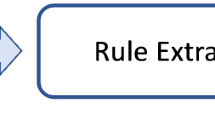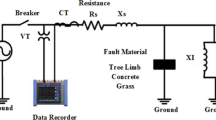Abstract
Unscheduled power disturbances cause severe consequences for customers and grid operators. To avoid such events, it is important to identify the causes and localize the sources of the disturbances in the power distribution network. In this work, we focus on a specific power grid in the Arctic region of Northern Norway that experiences an increased frequency of failures of unspecified origin. First, we built a data set by collecting relevant meteorological data and power consumption measurements logged by power-quality meters. Then, we exploited machine-learning techniques to detect disturbances in the power supply and to identify the most significant variables that should be monitored. Specifically, we framed the problem of detecting faults as a supervised classification and used both linear and non-linear classifiers. Linear models achieved the highest classification performances and were able to predict the failures reported with a weighted F1-score of 0.79. The linear models identified the amount of flicker and wind speed of gust as the most significant variables in explaining the power disturbances. Our results could provide valuable information to the distribution system operator for implementing strategies to prevent and mitigate incoming failures.
Access this chapter
Tax calculation will be finalised at checkout
Purchases are for personal use only
Similar content being viewed by others
References
Abusdal, G.M., Heydt, G.T., Ripegutu, A.: Utilization of advanced metering infrastructure in back-fed ground fault detection. In: 2015 IEEE Power & Energy Society General Meeting, pp. 1–5. IEEE (2015)
Andresen, C.A., Torsæter, B.N., Haugdal, H., Uhlen, K.: Fault detection and prediction in smart grids. In: 2018 IEEE 9th International Workshop on Applied Measurements for Power Systems (AMPS), pp. 1–6. IEEE (2018)
Arva Power Company, T.K.: Arva power company, troms kraft. https://www.tromskraftnett.no/hovedsiden
Balouji, E., Gu, I.Y., Bollen, M.H., Bagheri, A., Nazari, M.: A LSTM-based deep learning method with application to voltage dip classification. In: 2018 18th International Conference on Harmonics and Quality of Power (ICHQP), pp. 1–5 (2018). https://doi.org/10.1109/ICHQP.2018.8378893
Bianchi, F.M., De Santis, E., Rizzi, A., Sadeghian, A.: Short-term electric load forecasting using echo state networks and PCA decomposition. IEEE Access 3, 1931–1943 (2015)
Bianchi, F.M., Maiorino, E., Kampffmeyer, M.C., Rizzi, A., Jenssen, R.: Recurrent Neural Networks for Short-term Load Forecasting: an Overview and Comparative Analysis (2017)
Chen, K., Hu, J., Zhang, Y., Yu, Z., He, J.: Fault location in power distribution systems via deep graph convolutional networks. IEEE J. Sel. Areas Commun. 38(1), 119–131 (2020). https://doi.org/10.1109/JSAC.2019.2951964
Chiaradonna, S., Di Giandomenico, F., Masetti, G.: Analyzing the impact of failures in the electric power distribution grid. In: 2016 Seventh Latin-American Symposium on Dependable Computing (LADC), pp. 99–108. IEEE (2016)
Csanyi, E.: Detailed overview of power system disturbances (causes and impacts). https://electrical-engineering-portal.com/detailed-overview-of-power-system-disturbances-causes-and-impacts
De Caro, F., Carlini, E., Villacci, D.: Flexibility sources for enhancing the resilience of a power grid in presence of severe weather conditions. In: 2019 AEIT International Annual Conference (AEIT), pp. 1–6. IEEE (2019)
Ferrari, R.M.G., Parisini, T., Polycarpou, M.M.: Distributed fault detection and isolation of large-scale discrete-time nonlinear systems: an adaptive approximation approach. IEEE Trans. Autom. Control 57(2), 275–290 (2012). https://doi.org/10.1109/TAC.2011.2164734
Foldvik Eikeland, O., Bianchi, F.M., Chiesa, M.: Uncovering contributing factors to interruptions in the power grid. Arxiv preprint (2021)
Gopinath, G.S., Meher, M.: Electricity a basic need for the human beings. In: AIP Conference Proceedings, vol. 1992, p. 040024. AIP Publishing LLC (2018)
Hoffmann, V., Michałowska, K., Andresen, C., Torsæter, B.N.: Incipient fault prediction in power quality monitoring (2019)
Khorasgani, H., Hasanzadeh, A., Farahat, A., Gupta, C.: Fault detection and isolation in industrial networks using graph convolutional neural networks. In: 2019 IEEE International Conference on Prognostics and Health Management (ICPHM), pp. 1–7 (2019). https://doi.org/10.1109/ICPHM.2019.8819403
Klinger, C., Owen Landeg, V.M.: Power outages, extreme events and health: a systematic review of the literature from 2011–2012. PLoS Currents, 6 (2014)
Lovdata, N.: Forskrift om leveringskvalitet i kraftsystemet. https://lovdata.no/dokument/SF/forskrift/2004-11-30-1557
Meles, T.H.: Impact of power outages on households in develo** countries: evidence from Ethiopia. Energy Econ. 91, 104882 (2020)
Owerko, D., Gama, F., Ribeiro, A.: Predicting power outages using graph neural networks. In: 2018 IEEE Global Conference on Signal and Information Processing (GlobalSIP), pp. 743–747. IEEE (2018)
Panteli, M., Mancarella, P.: Influence of extreme weather and climate change on the resilience of power systems: impacts and possible mitigation strategies. Electr. Power Syst. Res. 127, 259–270 (2015)
Pedregosa, F., et al.: Scikit-learn: machine learning in python. J. Mach. Learn. Res. 12, 2825–2830 (2011)
Perera, A., Nik, V.M., Chen, D., Scartezzini, J.L., Hong, T.: Quantifying the impacts of climate change and extreme climate events on energy systems. Nat. Energy 5(2), 150–159 (2020)
Rubí, C.: The challenges of upgrading the power grid for a decarbonised electric future. https://informaconnect.com/the-challenges-of-upgrading-the-power-grid-for-a-decarbonised-electric-future/
S. Mark Halpin, A.C.: Power Electronics Handbook, 2nd (edn.), chap. 38 - Power Quality. Academic Press, Department of Electrical and Computer Engineering, Auburn University, Alabama, USA (2007)
Sabouhi, H., Doroudi, A., Fotuhi-Firuzabad, M., Bashiri, M.: Electrical power system resilience assessment: a comprehensive approach. IEEE Syst. J. 14(2), 2643–2652 (2019)
Sapountzoglou, N., Lago, J., De Schutter, B., Raison, B.: A generalizable and sensor-independent deep learning method for fault detection and location in low-voltage distribution grids. Appl. Energy 276, 115299 (2020)
Shuai, M., Chengzhi, W., Shiwen, Y., Hao, G., Jufang, Y., Hui, H.: Review on economic loss assessment of power outages. Procedia Comput. Sci. 130, 1158–1163 (2018)
Trakas, D.N., Panteli, M., Hatziargyriou, N.D., Mancarella, P.: Spatial risk analysis of power systems resilience during extreme events. Risk Anal. 39(1), 195–211 (2019)
Tully, S.: The human right to access electricity. Electr. J. 19(3), 30–39 (2006)
Author information
Authors and Affiliations
Corresponding author
Editor information
Editors and Affiliations
Rights and permissions
Copyright information
© 2022 The Author(s), under exclusive license to Springer Nature Switzerland AG
About this paper
Cite this paper
Eikeland, O.F., Bianchi, F.M., Holmstrand, I.S., Bakkejord, S., Chiesa, M. (2022). Detecting the Linear and Non-linear Causal Links for Disturbances in the Power Grid. In: Sanfilippo, F., Granmo, OC., Yayilgan, S.Y., Bajwa, I.S. (eds) Intelligent Technologies and Applications. INTAP 2021. Communications in Computer and Information Science, vol 1616. Springer, Cham. https://doi.org/10.1007/978-3-031-10525-8_26
Download citation
DOI: https://doi.org/10.1007/978-3-031-10525-8_26
Published:
Publisher Name: Springer, Cham
Print ISBN: 978-3-031-10524-1
Online ISBN: 978-3-031-10525-8
eBook Packages: Computer ScienceComputer Science (R0)




